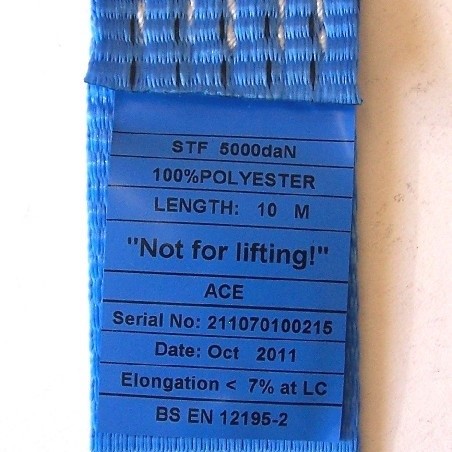If you work in the cargo and transportation industry, you will no doubt be familiar with ratchet load straps – the chances are, you will use them every day to secure cargo to your vehicle. But are you familiar with the information label that is typically found stitched at the end of the strap?
Most people are unaware of the importance of this label and it’s easy to see why. At first glance, it appears to be nothing more than a product code and a few details about the rope’s construction. However, in reality, this label is incredibly important. It provides vital information about the capabilities of your ratchet strap and, if it is missing (or illegible), you are not legally allowed to use it.
In the following blog, we examine this cargo strap label in detail – outlining the type of information it actually includes and exploring what each section of the label means for you as the user.
What information can be found on a ratchet strap label?
Webbing material
Ratchet tie down straps can be constructed from a range of different materials and this information is usually printed clearly at the top of the cargo label in block capital letters.
However, perhaps an easier way to determine the webbing material of a ratchet strap is to simply note the colour of the label. Most straps are made from polyester and these have a blue label, yet those made from polyamide are green and others made from polypropylene are brown. This is a quick off-the-cuff rule and it can help to give you a better understanding of the strap’s construction.
Production date
You should be able to find a date printed somewhere on the label, including a month and year. This is the production date (i.e. the date when your ratchet strap was manufactured) and, in combination with your supplier’s name, it can be used to trace the strap back to its exact production batch.
Lashing capacity
This sounds complicated; however, in reality, it is actually quite easy to understand. Lashing capacity (LC) is, essentially, the maximum force your heavy-duty ratchet strap can withstand, without it tearing or damaging in any way. It is usually measured in dekaNewton (daN) and, importantly, it should not be confused with the weight of cargo that your strap can safely restrain.
For example, a LC of 2500 daN does not mean that your strap can restrain 2500kg of cargo. In order to calculate the correct weight, the LC capacity should – in fact – be doubled. A lashing capacity of 2500 daN can, therefore, successfully endure a force equal to 5000kg (or 5 tonnes) in total.

Standard Hand Force
Standard Hand Force (SHF) is the total force that a user can apply to the tensioning device (or ratchet) on your cargo strap – before it would start to damage or break. Once again, this force is measured in daN and the universal standard is currently set at 50daN. This means that a ratchet should only be tightened by hand and not by standing on it or using tools such as a wrench.
Standard Tension Force
Standard tension force (STF) is another measurement that can be found on the label of your cargo ropes. Essentially, it is a measure of the tension (or force) that is created by your ratchet and lashing straps – when tying down a load of cargo – and, once again, it is expressed in terms of daN.
It is important to bear this measurement in mind when loading your cargo, as for straps with a higher STF, fewer straps will be needed, and each strap can be secured a little more tightly.
Total length and elongation
The total length of the ratchet load strap should be printed on the label, along with information about its allowed extension. This extension length is expressed as a percentage and in compliance with European standards, it should be no more than 7% of the strap’s total length at LC.
‘Not for lifting’ warning
Your ratchet strap label should also include the statement ‘Not for Lifting!’ in capital letters. This statement is there to remind users that the safety factors for lifting equipment are very different from those of lashing; therefore, under no circumstances, should your straps be used for lifting.

All ratchet load straps should comply with the European norm EN 12195-2 and, as part of this norm, each strap should have a label – with details about its construction and capabilities.

